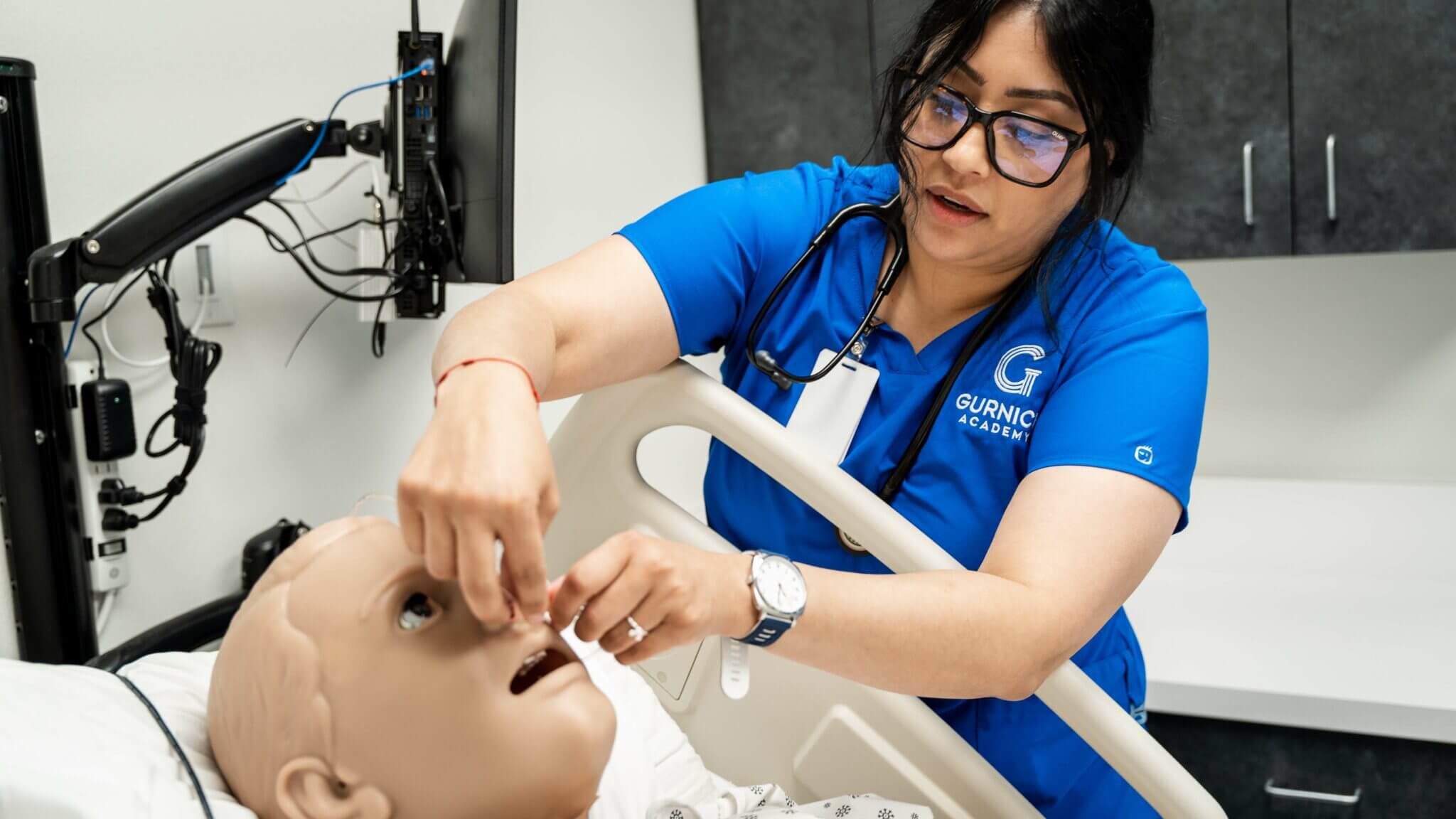You Can Become a Nurse Sooner Than You Realize
Date: August 16, 2022
The Entry-level Licensed Vocational Nurse
Working in hospitals, healthcare centers, and nursing homes, Licensed Vocational Nurses* (LVNs) provide care under the direct supervision of Registered Nurses (RNs).1 An LVN’s primary responsibility is to meet patients’ ongoing needs while giving optimum care. These duties include taking vitals, charting, monitoring patients, and relaying accurate, timely information to their teams. LVNs may also bandage wounds, change dressings, and provide light therapies such as walking patients. This nurse should not be confused with a Certified Nursing Assistant (CNA) because of an LVN:
- Has more training than a CNA;
- May administer medications; (This is a distinction between the LVN and CNA.)
- May most often apply their training to an RN program.2
A) How Long Does It Take to Become an LVN?
- According to CA.Gov, to practice as an LVN, one must:
- Obtain a high-school† or General Equivalency Diploma (GED);
- Complete an accredited VN program with clinical hours;
- Some states, including California, require Successful completion of a written examination titled the National Council Licensing Examination for Practical (Vocational) Nursing (NCLEX-PN), which certifies VNs to practice.3
Typically, one begins a VN program by entering a community college, private school, or online course. Gurnick Academy offers:
- 13-month VN diploma program (52 approved instructional weeks);
- 8-month A.S. in VN (ASVN) program; (VN diploma + eight (8) months/30 approved instructional weeks).
Students from either program must sit for and pass the NCLEX-PN. (Gurnick Academy students obtain a VN diploma before applying to the ASVN program, whereas schools often integrate both courses.) Because an associate degree takes only a year longer, it is usually a good option.
B) Should You Become an LVN?
LVN certification and licensure posture one for a caregiving role while providing a means toward a modest living. Because of their personalized care, LVNs leave lasting impressions on patients’ lives. Often one may enter the workforce quickly, gaining familiarity with industry terms, standard operating procedures, and practical experiences.
A VN program may be a viable option if you lack the financial resources or time to complete one’s education all at once. This program may offer a pause button to pursue one’s academic goals later or follow one’s aspirations in incremental steps. An LVN trajectory may serve as a “bridge” because credit hours can frequently be applied to advanced nursing degrees. I.e., With an LVN foundation, one may become an RN in as little as 33 additional weeks (two semesters and three weeks)–a saving of 19 weeks through credit-granted coursework. Generally, benefits like these make the time one spends as an LVN an investment.
Brief Glossary of Terms
An LVN is typically referred to as a degree, but an LVN is a title and a license. One may practice as an LVN upon completing an accredited Vocational Nursing program and obtaining licensure. After this, the licensee may be known as a Licensed Vocational Nurse and may place the letters “LVN” after their name.
Similarly, an RN is a title and a license. One is a Registered Nurse (RN) after achieving either an Associate or Bachelor’s Degree in Nursing, sitting for the NCLEX-RN, and obtaining licensure. Acronyms for qualifying degrees for RNs include:
- Associate Degree in Nursing (ADN);
- Associate of Science in Nursing (ASN);
- Associate of Applied Science in Nursing (AAS/AASN);
- Bachelor of Science in Nursing (BSN).
The Entry-level Registered Nurse
According to WebMD, an RN is a licensed medical professional who provides hands-on care in different medical and community settings. These professionals work in hospitals, doctor’s offices, nursing homes, prisons, long-term care facilities, and private homes.4 RNs answer to physicians, providing and coordinating patient care while educating patients and the public regarding health.5 These nurses may assess patient conditions, record medical symptoms and histories, administer medicine, perform and analyze diagnostic tests and create patient care plans.6 RNs typically:
- Supervise LVNs;
- Have more education than LVNs.6
A) How Long Does It Take to Become an RN?
One may become an RN with an entry-level associate degree. Gurnick Academy offers the following programs:
- A.S. in Nursing (ADN/ASN) generic pathway taking 23 months or 90 approved instructional weeks to complete;
- A.S. in Nursing advanced placement (LVN–RN) program takes eight (8) months or 33 approved instructional weeks for applicants holding LVN licensure to complete.
Students from either program must sit for and pass the NCLEX-RN.
B) Should You Become an RN?
When holding RN licensure (completing a two-year associate degree program + licensure), one can most often accelerate the time toward a Bachelor of Science in Nursing (BSN) degree. Most BSN programs take roughly four years to complete, from natural beginning to end.
Conversely, RNs can work, gain experience, and a salary, then meet an ADN to BSN route in as little as two years. The ASN and AAS are tailored to specific skill sets, and one may need to obtain special permissions or complete additional requirements before sitting for the NCLEX-RN. Because an ADN program transfers directly into a BSN program, an ADN is generally the preferred route for entry into a BSN program.
Traditional BSN programs comprise 120 credit hours needed for degree completion, including a 90-hour clinical residency.7 Some programs allow RN students to pursue BSNs by applying 60 credit hours from their associate degrees to bachelor’s degree programs, truncating the four-year BSN pathway’s timeframe. What traditionally takes two years to complete can be lessened to one year by applying for credits.‡
According to the US World and News Report, RNs rank #5 in Best Healthcare Jobs and #12 in 100 Best Jobs. Jobs are ranked according to their ability to offer an elusive mix of factors.9
How Can I Learn More?
Working in entry-level nursing positions can provide exposure to healthcare while testing if the role should be a lifetime career. If one decides to pursue the field, they have already entered the market. Are you interested in the nursing field and want to get started? Learn more about our nursing programs here.
*Every state, except for two, uses the term Licensed Practical Nurse (LPN). California and Texas refer to these professionals as Licensed Vocational Nurses (LVNs). Accrediting bodies see them as the same profession.8
† In some states, one does not need a high-school diploma to enter the VN vocation.8
‡Part-time students may require additional time to earn their bachelor’s degrees.
Citations
1 “29-2061.00–Licensed Practical and Licensed Vocational Nurses.” O*NET OnLine, National Center for O*NET Development. (Accessed July 29, 2022).
2 Staff. “LPN vs. CNA Salary + Core Differences|NurseJournal.org.” NurseJournal, NurseJournal.org, a Red Ventures Company. Jan. 20, 2022. (Accessed July 29, 2022).
3 “Summary of Requirements for Licensure as a Vocational Nurse–Board of Vocational Nursing and Psychiatric Technicians.” Www.bvnpt.ca.gov, State of California. (Accessed July 29, 2022).
4 WebMD Editorial Contributors. “What Is a Registered Nurse?” WebMD, WebMD, LLC., June 2021. (Accessed July 28, 2022).
5 Bureau of Labor Statistics, US Department of Labor, Occupational Outlook Handbook, Registered Nurses. (Accessed July 9, 2022).
6 ^a, b “LVN vs. LPN–What’s the Difference?” Nursing License Map, 2U, Inc., Nursing Map (Accessed July 29, 2022).
7 Staff Writers. 2020. “The Best LVN to BSN Programs in California.” Nurse Journal. Dec. 3, 2020. (Accessed May 20, 2021).
8 ^a, b Bucceri Androus, Amanda. 2020. “Who Can Use the Term Nurse?” Registered Nursing.org. Dec. 10, 2020. (Accessed May 20, 2021).
9 News, US. “Registered Nurse Ranks Among Best Jobs of 2019.” Usnews.com, US News and World Report L.P., 2016. (Accessed July 29, 2022).





